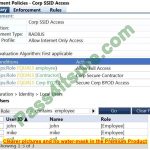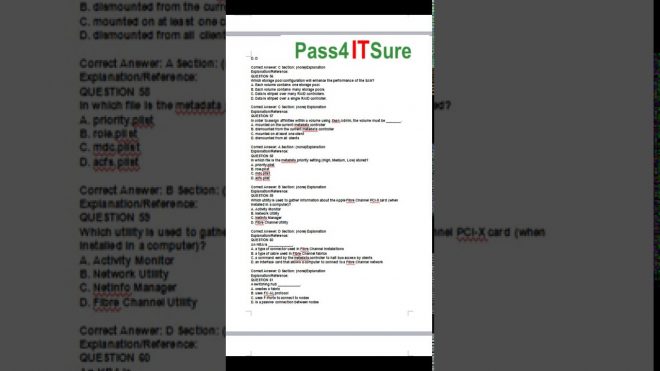With rapid development of IT industry, more and more requirements have been taken on those who are working in IT industry. So if you don’t want to be eliminated in the competition, to pass 070-341 actual test is a necessary for you. If you worry that you will not get the satisfied results after you have taken too much time and energy to prepare the 70-341 actual test. Now let our Pass4itsure help you! Countless 70-341 dump actual test software users of our Pass4itsure let us have the confidence to tell you that using our test software, you will have the most reliable guarantee to pass 070-341 actual test.
Exam Code: 70-341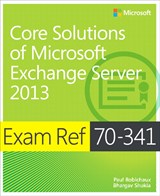
Exam Name: Core Solutions of Microsoft Exchange Server 2013
Updated: Mar 09, 2017
Q&As: 204
Published: January 15, 2013
Languages: English, Chinese (Simplified), French, German, Japanese, Portuguese (Brazil)
Audiences:IT professionals
Technology: Microsoft Exchange Server 2013
Credit toward certification: MCP, MCSE
Exam Information:https://www.pass4itsure.com/70-341.html
Who should take this exam?
This 70-341 exam is designed for candidates who have a minimum of three years of experience managing Exchange servers and who are responsible for the Exchange messaging environment in an enterprise environment. They are senior administrators who act as the technical lead over a team of administrators. These candidates are a third level of support between the Exchange Recipient Administrator and the Exchange Server Administrator.
Latest 70-341 Dump Exam Questions and Answers Updated (March 2017)#1-7
Topic 1, Fabrikam, Inc
Overview
Fabrikam, Inc., is a pharmaceutical company located in Europe. The company has 5,000
users. The company is finalizing plans to deploy an Exchange Server 2013 organization.
The company has offices in Paris and Amsterdam.
Existing Environment
Active Directory Environment
The network contains an Active Directory domain named fabrikam.com. An Active Directory
site exists for each office.
Network Infrastructure
The roles and location of each server are configured as shown in the following table.
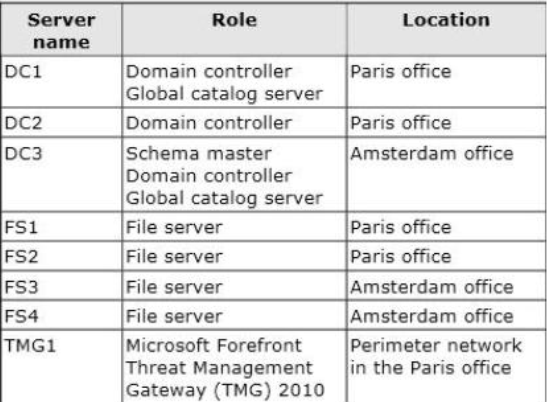
Client computers run either Windows 7 or Windows 8 and have Microsoft Office 2010
installed.
The Paris office uses the 192.168.1.0/24 IP range. The Amsterdam office uses the
192.168.2.0/24 IP range.
The offices connect to each other by using a high-speed, low-latency WAN link. Each office
has a 10-Mbps connection to the Internet.
Planned Exchange Infrastructure
The company plans to deploy five servers that run Exchange Server. The servers will be
configured as shown in the following table.
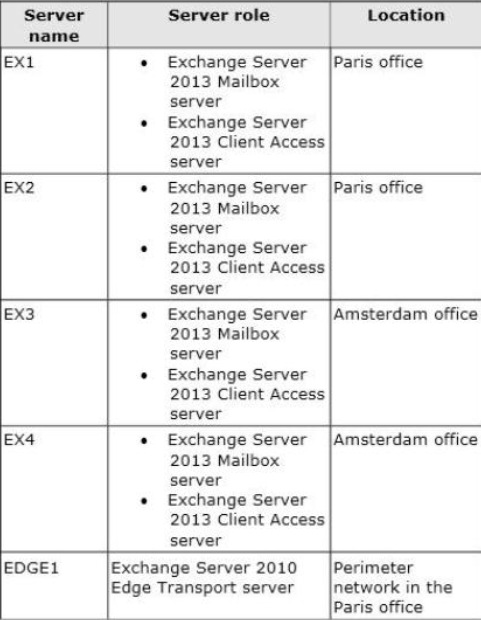
The company plans to have mailbox databases replicated in database availability groups
(DAGs). The mailbox databases and DAGs will be configured as shown in the following
table.

✑ ✑ ✑ ✑ ✑ ✑ ✑ ✑ ✑ ✑
DAG1 will use FS1 as a file share witness. DAG2 will use FS3 as a file share witness.
You plan to create the following networks on each DAG:
A dedicated replication network named DAGNET1
A MAPI network named DAGNET2
All replication traffic will run on DAGNET1. All client connections will run on DAGNET2.
Client connections must never occur on DAGNET1. Replication traffic must only occur on
DAGNET2 if DAGNET1 is unavailable.
Each Exchange Server 2013 Mailbox server will be configured to have two network
adapters.
The following two mailbox databases will not be replicated as part of the DAGs:
A mailbox database named AccountingDB that is hosted on EX1
A mailbox database named TempStaffDB that is hosted on EX4
EDGE1 will have an Edge Subscription configured, with both EX1 and EX2 as targets.
Requirements
Planned Changes
An external consultant reviews the Exchange Server 2013 deployment plan and identifies
the following areas of concern:
The DAGs will not be monitored.
Multiple Edge Transport servers are required to prevent the potential for a single
point of failure.
Technical Requirements
Fabrikam must meet the following technical requirements:
Email must be evaluated for SPAM before the email enters the internal network.
Production system patching must minimize downtime to achieve the highest
possible service to users.
Users must be able to use the Exchange Control Panel to autonomously join and
disjoin their department’s distribution lists.
Users must be able to access all Internet-facing Exchange Server services by
using the names of mail.fabrikam.com and autodiscover.fabrikam.com.
The company establishes a partnership with another company named A. Datum Corporation. A. Datum uses the SMTP suffix adatum.com for all email addresses.
Fabrikam plans to exchange sensitive information with A. Datum and requires that the
email messages sent between the two companies be encrypted. The solution must use
Domain Security.
Users in the research and development (R&D) department must be able to view only the
mailboxes of the users in their department from Microsoft Outlook. The users in all of the
other departments must be prevented from viewing the mailboxes of the R&D users from
Outlook.
Administrators plan to produce HTML reports that contain information about recent status
changes to the mailbox databases.
Fabrikam is evaluating whether to abort its plan to implement an Exchange Server 2010
Edge Transport server and to implement a Client Access server in the Paris office instead.
The Client Access server will have anti-spam agents installed.
Question No : 1 HOTSPOT – (Topic 1) You need to recommend which configurations must be set for each network.
Which configurations should you recommend?
To answer, select the appropriate configurations for each network in the answer area.
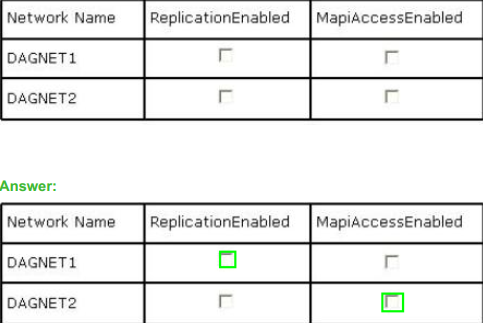
70-341 dump Question No : 2 – (Topic 1) An administrator recommends removing EDGE1 from the implementation plan and adding
a new Client Access server named CAS-8 instead.
You need to identify which anti-spam feature will NOT be available on CAS-8.
Which anti-spam feature should you identify?
A. Connection Filtering
B. Sender Filtering
C. Content Filtering
D. Recipient Filtering
Answer: A
Explanation:
EDGE1 is an exchange server 2010
CAS-8 would be an exchange server 2013
Typically, you would enable the anti-spam agents on a mailbox server if your organization
doesn’t have an Edge Transport server, or doesn’t do any prior anti-spam filtering before
accepting incoming messages.
Connection Filtering agent is only available on the Edge Transport server role. Exchange
2013 does not have an Edge Transport server role yet.
The Connection Filter agent and the Attachment Filter agent are only available on an Edge
Transport server.
Connection Filtering on Edge Transport Servers: Exchange 2013 Help
Anti-spam agents on Legacy Edge Transport servers
If your organization has an Exchange 2007 or Exchange 2010 Edge Transport server
installed in the perimeter network, all of the anti-spam agents that are available on a
Mailbox server are installed and enabled by default on the Edge Transport server.
However, the following anti-spam agents are only available on an Edge Transport server:
Connection Filtering agent Connection filtering inspects the IP address of the remote server
that’s trying to send messages to determine what action, if any, to take on an inbound
message. The remote IP address is available to the Connection Filtering agent as a
byproduct of the underlying TCP/IP connection that’s required for the SMTP session.
Connection filtering uses a variety of IP Block lists, IP Allow lists, as well as IP Block List
provider services or IP Allow List provider services to determine whether the connection
from the specific IP should be blocked or allowed in the organization. For more information about connection filtering in Exchange 2010, see Attachment Filter agent Attachment filtering filters messages based on attachment file
name, file name extension, or file MIME content type. You can configure attachment
filtering to block a message and its attachment, to strip the attachment and allow the
message to pass through, or to silently delete the message and its attachment. For more
information about attachment filtering in Exchange 2010, see Feature
Anti-spam agent management in the EMC
In Exchange 2010, when you enabled the anti-spam agents on the Hub Transport server,
you could manage the anti-spam agents in the Exchange Management Console (EMC). In
Exchange 2013, when you enable the anti-spam agents in the Transport service on a
Mailbox server, you can’t manage the agents in the Exchange admin center (EAC). You
can only use the Exchange Management Shell. For information about how to enable the
anti-spam agents on a Mailbox server, see Enable Anti-Spam Functionality on a Mailbox
Server.
Connection Filtering agent on Hub Transport servers
In Exchange 2010, when you enabled the anti-spam agents on a Hub Transport server, the
Attachment Filter agent was the only anti-spam agent that wasn’t available. In Exchange
2013, when you enable the antispam agents in the Transport service on a Mailbox server,
the Attachment Filter agent and the Connection Filtering agent aren’t available. The
Connection Filtering agent provides IP Allow List and IP Block List capabilities. For
information about how to enable the anti-spam agents on a Mailbox server, see Enable
Anti-Spam Functionality on a Mailbox Server.
Note:
You can’t enable the anti-spam agents on an Exchange 2013 Client Access server.
Therefore, the only way to get the Connection Filtering agent is to install an Exchange 2010
or Exchange 2007 Edge Transport server in the perimeter network. For more information,
see Use an Edge Transport Server in Exchange 2013.
Sender Filter agent
Sender filtering compares the sender on the MAIL FROM: SMTP command to an
administrator-defined list of senders or sender domains who are prohibited from sending
messages to the organization to determine what action, if any, to take on an inbound message.
Content Filter agent
Content filtering assesses the contents of a message.
Spam quarantine is a feature of the Content Filter agent that reduces the risk of losing
legitimate messages that are incorrectly classified as spam. Spam quarantine provides a
temporary storage location for messages that are identified as spam and that shouldn’t be
delivered to a user mailbox inside the organization. For more information, Recipient Filter
agent
Recipient filtering compares the message recipients on the RCPT TO: SMTP command to
an administratordefined Recipient Block list. If a match is found, the message isn’t
permitted to enter the organization
A
You can’t enable the anti-spam agents on an Exchange 2013 Client Access server.
Therefore, the only way to get the Connection Filtering agent is to install an Exchange 2010
or Exchange 2007
Edge Transport server in the perimeter network
Connection Filtering agent is only available on the Edge Transport server role. Exchange
2013 does not have an Edge Transport server role yet.
NOT B C D
Only need to identify 1 and this is connection filtering.
Question No : 3 – (Topic 1)
You need to recommend which task is required to prepare Active Directory for the planned
Exchange Server 2013 implementation.
What should you recommend?
A. On any domain controller in the Paris office, run setup.exe /preparead.
B. On any domain controller in the Amsterdam office, run setup.exe /preparead.
C. On any domain controller in the Paris office, run setup.exe /preparealldomains.
D. On any domain controller in the Amsterdam office, run setup.exe /preparedomain.
Answer: B
Explanation:
B
The schema master is in the Amsterdam office.
Before you install the release to manufacturing (RTM) version of Microsoft Exchange
Server 2013 or later cumulative updates (CU) on any servers in your organization, you
must prepare Active Directory and domains.
Run setup.exe /preparead on the schema master.
NOT A C
The schema master is in the Amsterdam office.
Run setup.exe /preparead on the schema master.
NOT D
Fabrikam has a single domain.
In order to prepare a domain, run the following command from an elevated command
prompt after browsing to the Exchange 2013 DVD/ISO.
Setup.exe /PrepareDomain /IAcceptExchangeServerLicenseTerms
If you have a single domain environment, you don’t have to prepare the domain as the local
domain is prepared for 2013 as part of preparing the AD. But, if you have a multi-domain
environment, all other domains (except the one on which the AD was prepared) has to be
ready for 2013.
You can prepare all the domains in one go by running the command below.
Setup.exe /PrepareAllDomains /IAcceptExchangeServerLicenseTerms (you will need
Enterprise Admin rights).
Prepare Active Directory and Domains: Exchange 2013 Help
070-341 dump Question No : 4 – (Topic 1) You need to recommend a design that meets the technical requirements for communication
between Fabrikam and A. Datum.
Which three actions should you perform in fabrikam.com? (Each correct answer presents
part of the solution. Choose three.)
A. Create a remote domain for adatum.com.
B. Exchange certificates with the administrators of adatum.com.
C. From EDGE1, create a Send connector that has an address space for adatum.com
D. Run the Set-TransportConfigcmdlet.
E. Run the Set-TransportServercmdlet.
F. From a Mailbox server, create a Send connector that has an address space for
adatum.com.
Answer: B,D,F
Explanation:
NOT A
Applies to: Exchange Server 2013, Exchange Online
Remote domains are SMTP domains that are external to your Microsoft Exchange
organization. You can create remote domain entries to define the settings for message
transferred between your Exchange organization and specific external domains. The
settings in the remote domain entry for a specific external domain override the settings in
the default remote domain that normally apply to all external recipients. The remote domain
settings are global for the Exchange organization.
You can create remote domain entries to define the settings for message transfers
between your Exchange Online organization and external domains. When you create a
remote domain entry, you control the types of messages that are sent to that domain. You
can also apply message format policies and acceptable character sets for messages that
are sent from users in your organization to the remote domain.
NOT C
Edge1 is in the perimeter network and the send connector needs to be created on a
mailbox server
NOT E
Set-TransportServercmdlet.
Use the Set-TransportServer cmdlet to set the transport configuration options for the
Transport service on Mailbox servers or for Edge Transport servers.
This example sets the DelayNotificationTimeout parameter to 13 hours on server named
Mailbox01.
Set-TransportServer Mailbox01 -DelayNotificationTimeout 13:00:00
Need Set-TransportConfig and the TLSReceiveDomainSecureList parameter to specify the
domains from which you want to receive domain secured email by using mutual Transport
Layer Security (TLS) authentication.
B
To activate SSL encryption on an Exchange server, you need a server certificate on the
Client Access Server in each company. The client access server is the internet facing
server in an organization.
An SSL certificate is a digital certificate that authenticates the identity of the exchange
server and encrypts information that is sent to the server using Secure Sockets Layer
(SSL) technology
Mailbox server certificates
One key difference between Exchange 2010 and Exchange 2013 is that the certificates
that are used on the Exchange 2013 Mailbox server are self-signed certificates.
Because all clients connect to an Exchange 2013 Mailbox server through an Exchange
2013 Client Access server, the only certificates that you need to manage are those on the
Client Access server.
The Client Access server automatically trusts the self-signed certificate on the Mailbox
server, so clients will not receive warnings about a self-signed certificate not being trusted,
provided that the Client Access server has a non-self-signed certificate from either a
Windows certification authority (CA) or a trusted third party.
There are no tools or cmdlets available to manage self-signed certificates on the Mailbox
server. After the server has been properly installed, you should never need to worry about
the certificates on the Mailbox server.
D
Set-TransportConfig.
Use the Set-TransportConfig cmdlet to modify the transport configuration settings for the
whole
Exchange organization.
EXAMPLE 1
This example configures the Exchange organization to forward all DSN messages that
have the DSN codes
5.7.1, 5.7.2, and 5.7.3 to the postmaster email account.
Set-TransportConfig -GenerateCopyOfDSNFor 5.7.1,5.7.2,5.7.3
The TLSReceiveDomainSecureList parameter specifies the domains from which you want
to receive domain secured email by using mutual Transport Layer Security (TLS)
authentication.
F
If you want to ensure secure, encrypted communication with a partner, you can create a
Send connector that is configured to enforce Transport Layer Security (TLS) for messages
sent to a partner domain. TLS provides secure communication over the Internet.
Use the EAC to create a Send connector to send email to a partner, with TLS applied
To create a Send connector for this scenario, log in to the EAC and perform the following
steps:
In the EAC, navigate to Mail flow > Send connectors, and then click Add .
In the New send connector wizard, specify a name for the send connector and then select
Partner for the Type.
When you select Partner, the connector is configured to allow connections only to servers
that authenticate with TLS certificates. Click Next.
Verify that MX record associated with recipient domain is selected, which specifies that the
connector uses the domain name system (DNS) to route mail. Click Next.
Under Address space, click Add . In the Add domain window, make sure SMTP is listed as
the Type. For Fully Qualified Domain Name (FQDN), enter the name of your partner
domain. Click Save.
For Source server, click Add . In the Select a server window, select a Mailbox server that
will be used to send mail to the Internet via the Client Access server and click Add . After
you’ve selected the server, click Add .
Click OK.
Click Finish.
Once you have created the Send connector, it appears in the Send connector list.
Send Connector
In Microsoft Exchange Server 2013, a Send connector controls the flow of outbound
messages to the receiving server.
They are configured on Mailbox servers running the Transport service. Most commonly,
you configure a Send connector to send outbound email messages to a smart host or
directly to their recipient, using DNS.
Exchange 2013 Mailbox servers running the Transport service require Send connectors to
deliver messages to the next hop on the way to their destination.
Send connectors that are created on Mailbox servers are stored in Active Directory and are
available to all Mailbox servers running the Transport service in the organization.
Send Connectors: Exchange 2013 Help
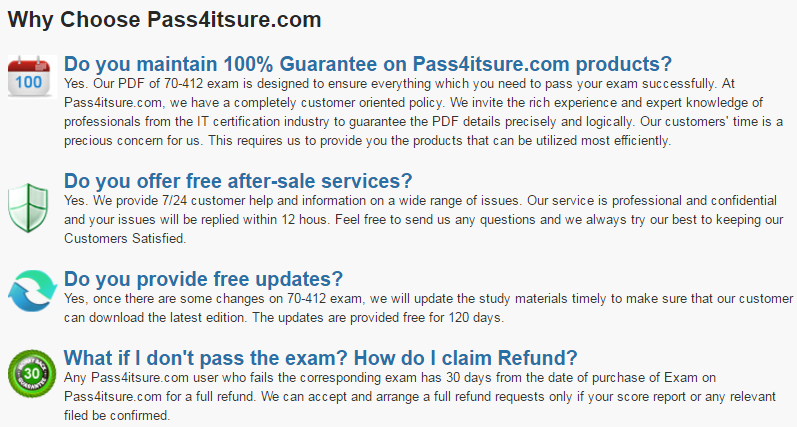
Pass4itsure’s training materials can test your knowledge in preparing for the exam, and can evaluate your performance within a fixed time. The instructions given to you for your weak link, so that you can prepare for the exam better. The Pass4itsure’s Microsoft 70-341 dump study materials introduce you many themes that have different logic. So that you can learn the various technologies and subjects. We guarantee that our training materials has tested through the practice. Pass4itsure have done enough to prepare for your exam. https://www.pass4itsure.com/70-341.html material is comprehensive, and the price is reasonable.
Official Site:https://www.microsoft.com/en-us/learning/exam-70-341.aspx
